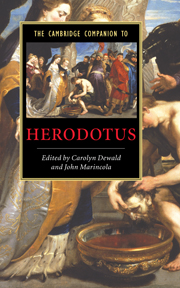Book contents
- Frontmatter
- Introduction
- 1 Herodotus and the poetry of the past
- 2 Herodotus and his prose predecessors
- 3 Herodotus and tragedy
- 4 The intellectual milieu of Herodotus
- 5 Meta-historiē: Method and genre in the Histories
- 6 The syntax of historiē: How Herodotus writes
- 7 Speech and narrative in the Histories
- 8 Herodotus, Sophocles and the woman who wanted her brother saved
- 9 Stories and storytelling in the Histories
- 10 Humour and danger in Herodotus
- 11 Location and dislocation in Herodotus
- 12 Herodotus and the natural world
- 13 Herodotus and Greek religion
- 14 Warfare in Herodotus
- 15 Herodotus, political history and political thought
- 16 Herodotus and the cities of mainland Greece
- 17 An alternate world: Herodotus and Italy
- 18 Herodotus and Persia
- 19 Herodotus and foreign lands
- 20 Herodotus' influence in antiquity
- Glossary
- Timeline
- Bibliography
- Index
- Series List
18 - Herodotus and Persia
Published online by Cambridge University Press: 28 January 2007
- Frontmatter
- Introduction
- 1 Herodotus and the poetry of the past
- 2 Herodotus and his prose predecessors
- 3 Herodotus and tragedy
- 4 The intellectual milieu of Herodotus
- 5 Meta-historiē: Method and genre in the Histories
- 6 The syntax of historiē: How Herodotus writes
- 7 Speech and narrative in the Histories
- 8 Herodotus, Sophocles and the woman who wanted her brother saved
- 9 Stories and storytelling in the Histories
- 10 Humour and danger in Herodotus
- 11 Location and dislocation in Herodotus
- 12 Herodotus and the natural world
- 13 Herodotus and Greek religion
- 14 Warfare in Herodotus
- 15 Herodotus, political history and political thought
- 16 Herodotus and the cities of mainland Greece
- 17 An alternate world: Herodotus and Italy
- 18 Herodotus and Persia
- 19 Herodotus and foreign lands
- 20 Herodotus' influence in antiquity
- Glossary
- Timeline
- Bibliography
- Index
- Series List
Summary
In 546 BCE, when the Persians were laying siege to the Greek cities of Ionia following the defeat of Croesus, king of Lydia, the Spartans sent a single ship with a message for Cyrus the Great, the founder of the Persian empire (1.152-3). Cyrus was warned by a Spartan envoy not to harm any city of Greece, for the Spartans would not permit it. In reaction to this piece of effrontery, Cyrus asked other Greeks who were present: 'Who among men are the Lacedaemonians, and how many of them are there that they give such orders?' The modern reader of the text of Herodotus will have no trouble recognising the Spartans (here called Lacedaemonians), and might well know that there were not many of them, and that only 300 of them faced the Persians at the battle of Thermopylae in 480 BCE. But he or she is far less likely to know much about the Persians, other than that there were a whole lot of them and that they failed to conquer Greece and were themselves, at a much later date (334-331 BCE), conquered by Alexander the Great.
It may come as a surprise then that the Histories of Herodotus is as much about Persia as about Greece, and that individual Persians are given just as much narrative space as individual Greeks. In fact the Persian kings Cyrus, Cambyses, Darius, and Xerxes, as well as Xerxes' cousin Mardonius, figure even more largely in the narrative than the Athenian general Themistocles or the Spartan king Leonidas. On a larger scale, the whole structure of the Histories is built upon the birth, growth, and checking of the Persian empire. The Persians are the driving force of the history, and the advance of the narrative is inextricably linked to their efforts to expand their empire. It can hardly be a coincidence that both the first (1.1-4) and the last (9.122) narratives in this massive work are focalised through the eyes of the Persians.
- Type
- Chapter
- Information
- The Cambridge Companion to Herodotus , pp. 274 - 289Publisher: Cambridge University PressPrint publication year: 2006
- 6
- Cited by

